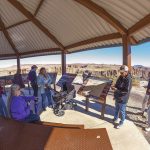
50 years ago: Flagstaff takes proactive stance toward complaints by Diné
The late 60s and early 70s were a tense time for some of the communities bordering the reservation as Navajo youth organizations began holding protests and complaining about how people in those communities treated Navajos who went there to shop.
Gallup and Farmington especially came under a lot of scrutiny during those times. And while Flagstaff was not exempt from criticism, it had nowhere near the number of problems that Gallup and Farmington had.
This was partly due to the fact the political leadership in Flagstaff began a major effort in 1969 to improve the relations between businesses in the community and the Navajo people.
The effort was spearheaded by the Flagstaff Chamber of Commerce, which began hosting a series of meetings with business owners in the community in February of 1969 to address the problems and to come up with guidelines that would address many of the concerns Navajos had about the way they were treated when they came to the community to shop.
Fifty years ago this week, officials of the chamber came to Window Rock and met with Dick Hardwick, the managing editor of the Navajo Times, to explain to him what they were doing.
Their plans included the establishment of an Indian Relations Committee that would meet periodically with leaders of the various tribes located in their area of the state. The committee would also receive complaints from individual Native Americans if they felt they had been mistreated during a visit to the city.
H. B. Warnock, president of the chamber, said there was also discussion about funding an Indian center in the community if they could find the funding.
In other news, officials for the Navajo Area Native American Church announced plans to travel to Texas in March to meet with members of the Texas legislature in an effort to get the state to stop designating peyote as a dangerous drug.
In 1967, the state legislature passed an amendment to its Dangerous Drug Act to include peyote, even when it was being used by members of the NAC during religious ceremonies. That provision had been ruled unconstitutional by the federal courts but it was still on the books and was still being enforced by law enforcement agencies in the state.
This proved to be a major problem for NAC members because many acquired the peyote they used in ceremonies by going to Mexico. This was before the establishment of farms in Texas that would grow peyote for NAC members to use in their ceremonies.
Even though it was legal according to federal law, NAC members still were worried about being stopped on their way back as they drove through Texas.
Angelo LeMere, treasurer of the national organization, was planning to go with the Navajo delegation.
“We must defend our right to use peyote in the practice of our religion and also have access to it without infringing on the rights and safety of others,” he said.
By this time, almost all of the other states had changed their laws to allow the use of peyote but Texas was a different matter as several more conservative members of the state legislature vowed to fight any attempt to change the law.
And finally, while she didn’t make a big thing of it, Julia Hanson was told by a Navajo family that she could not come into their hogan.
Hanson, a Democrat, was chair of the Interior Subcommittee for the House Appropriations Committee. She was part of a delegation that spent a day on the reservation observing how federal dollars were being spent to help the Navajos.
The group spent the days in Ganado and Chinle, visiting places like the Hubbell Trading Post and the BIA schools in the area.
But as the group was leaving Chinle on its way back to the Window Rock Airport, Hanson expressed a desire to see a hogan because she had heard so much about them but had never been inside of one.
This took Navajo officials by surprise since nothing had been planned in advance but they said it would be no problem so on their way back, they saw a hogan not to far from the highway and stopped to allow Hanson a chance to go inside.
But they were in for another surprise — the family refused to allow the Congresswoman inside their home.
The family didn’t give a reason. They just refused and Hanson said she could understand their feelings.
“I don’t blame them a bit,” she said. “If someone came up trying to get a look inside of my house, I wouldn’t let them in either.”
To read the full article, pick up your copy of the Navajo Times at your nearest newsstand Thursday mornings!
Are you a digital subscriber? Read the most recent three weeks of stories by logging in to your online account.








 Highway 264,
Highway 264, I-40, WB @ Winslow
I-40, WB @ Winslow